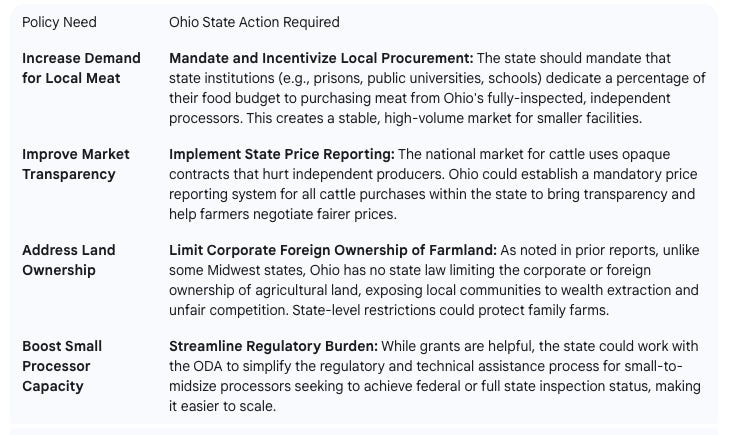Beyond the Grant: Why Ohio Policy Is the Missing Weapon Against the Meat Oligopoly
The issue of corporate control in the U.S. meatpacking industry, as highlighted in this blog post, has a direct and urgent impact on Ohio’s agricultural sector. While the federal government has an action plan, Ohio needs robust state-level policy to aggressively support its independent processors and combat the effects of national oligopoly to ensure fairness for its farmers and better prices for its consumers.
Ohio’s policy focus should shift from simply regulating existing facilities to actively restructuring the local food system to diminish the leverage of the “Big Four” national packers (Tyson, JBS, Cargill, etc.).
Ohio’s Current Efforts and Policy Gaps
Ohio has recognized the processing bottleneck, especially after COVID-19 exposed supply chain fragilities, and has taken positive steps:The Ohio Meat Processing Grant Program: The state has invested nearly $42 million across four rounds to help 179 local processors expand capacity, upgrade equipment, and improve facilities. This directly addresses the critical lack of processing access for Ohio livestock producers.
Inspections: The Ohio Department of Agriculture (ODA) oversees 177 fully-inspected facilities, which are essential for allowing processed meat to be sold wholesale within the state.
However, these efforts largely focus on modernization and capacity, which are necessary but not sufficient to restore true market competition.

The Economic and Community Imperative
The need for better policy is not just about meat—it’s about the vitality of Ohio’s rural economy:Farmer Survival: A lack of competition means large Ohio sheep and cattle producers often have to ship their livestock out of state for processing, increasing costs and removing local jobs. Strengthening the regional food processing hub keeps economic value within Ohio.
Consumer Protection: By fostering competition among local processors, the state can create alternative supply chains that are less susceptible to the price manipulation and supply shocks caused by national oligopolies, leading to more stable and fairer prices for Ohio consumers.
Resilience: A distributed network of smaller, independent processors is inherently more resilient than a few large, bottlenecked plants. Ohio policy must prioritize local resilience over corporate efficiency.
Ohio must leverage its existing grant program and pair it with direct-demand policies and regulatory changes to turn small-processor expansion into a structural shift that truly restores competition.



Comments